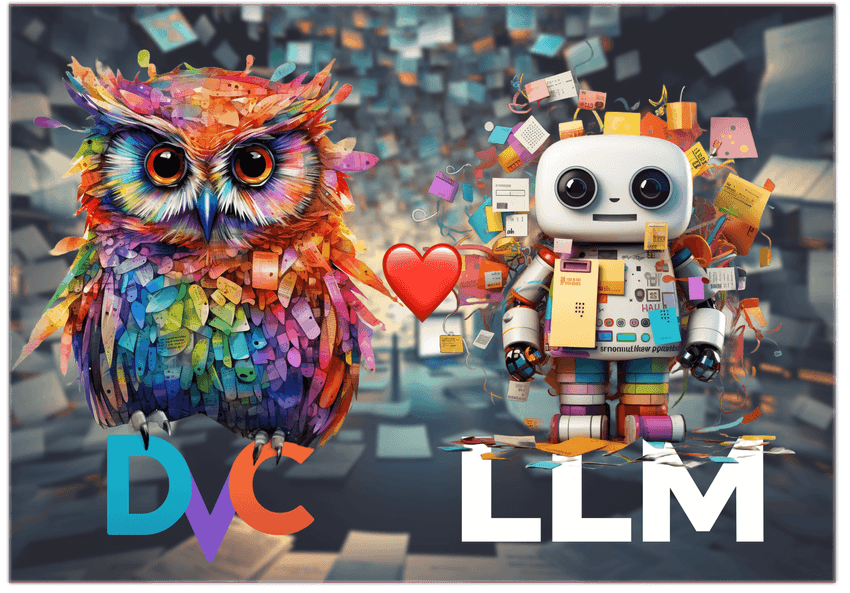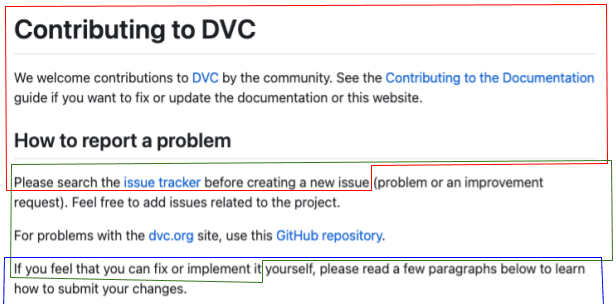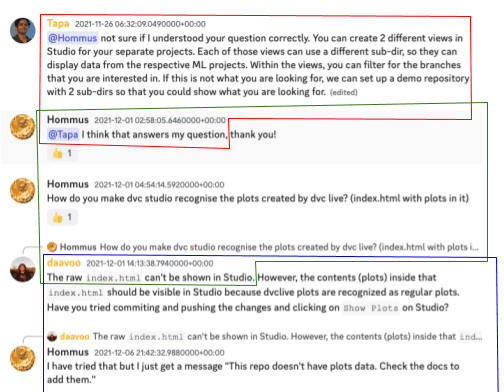Leveraging LLMs in Chatbots: The DVC Approach
This post explores how the Data Version Control (DVC) tool can enhance the efficiency and organization in designing LLM applications, using a Retrieval-Augmented Generation (RAG) chatbot as an example. This chatbot uses the RAG approach for its computational efficiency, provides cited sources for its answers, and leverages DVC features such as rollback capability, preventing redundant computations, and visual representation through a Directed Acyclic Graph (DAG).

In the modern world of Machine Learning (ML) and Natural Language Processing (NLP), there's been a surge in applications built on top of Large Language Models (LLMs). There has been an almost exponential adoption in applications and companies building applications from LLMs across a variety of areas.
In this post we will show how DVC can make designing LLM applications more efficient and organized. We take a Retrieval-Augmented Generation (RAG) approach and illustrate how we can break down the various phases of a RAG chatbot and version them with DVC. We can use DVC to both "time travel" and avoid the need to re-compute stages unnecessarily with little extra effort.
The Rise of Chatbots in Technical Advice
Chatbots are finding a natural fit in providing technical advice. For our product, DVC, which has amassed significant popularity, we've introduced a chatbot designed to streamline user experience. Our bot sources information not just from our official documentation but also from our community discussions on Discord. This creates a broader knowledge base than using our official documentation alone, and ensures a balanced mix of official guidelines and community insights.
The RAG Approach
Our chatbot uses the Retrieval-Augmented Generation (RAG) approach. The debate between the efficacy of RAG vs. fine-tuning methods is ongoing and lively. However, our choice leans towards RAG due to its simplicity and relative computation efficiency for quickly iterating on different approaches.

Citation: A Key Differentiator
A common complaint about chatbots is that they do not cite any sources, which leaves users with few avenues to validate the information provided by the chatbot.
 Demo
of our chatbot
Demo
of our chatbot
Our chatbot is able to cite the sources of its answers. It does with using the LangChain RetrievalQAWithSourcesChain. This is a key feature for many users.
Building the Chatbot Using DVC
Our chatbot builds on top of the LangChain Notion Question-Answering example using DVC to manage the pipeline. Interestingly, while we built a chatbot for DVC, we also employed DVC in its construction. This seemingly circular approach allowed us to leverage the standard benefits that DVC offers:
- Rollback Facility: The ability to revert to previous versions is invaluable, especially when dealing with unpredictable outputs in response to varying prompts.
- Efficiency: DVC prevents redundant computation when updating specific phases, saving both time and computational resources.
- Visual Representation with DVC DAG: The Directed Acyclic Graph (DAG) provided by DVC visualizes how the chatbot's construction is broken down into distinct stages, aiding understanding and development.
+----------------------+
| discord_dump.zip.dvc |
+----------------------+
+-------------------+
| docs_dump.zip.dvc |
+-------------------+
*
*
*
+--------+
| expand |
+--------+
*
*
*
+--------+
| ingest |
+--------+
*
*
*
+-----------+ +-----------------+
| vectorize | | samples.txt.dvc |
+-----------+ +-----------------+
*** ***
* *
** **
+-----+
| run |
+-----+The bot is built into a few standard phases for RAG:
expand: unzip archives of documentsingest: This is how we chunk up the text of the documents into small pieces that we can embed and also put into prompts for the chatbot. The standard text splitters make sense for documentation pages, but a dump of 2 years worth of Discord chats require a custom splitter.vectorize: Build a vector database with embeddings of all the text chunksrun: Extract the relevant text chunks for the sample questions, put into prompts, and call the LLM
DVC allows us to keep the outputs from each stage under version control, and manage the parameterization, with little extra effort. This provides the advantage that if we choose to update the vectorize stage, we can reuse the outputs of the ingest stage without re-running it. Or, if we want to roll back to an old version of vectorize, we can get that intermediate output back without re-running it and without the high chance of making a mistake in versioning if we try to do that manually.
Both the vectorize and run stages use the OpenAI API. So, repeated computation not only costs time but also actual dollars.


The Importance of Rollback
Changes in chatbot prompts can have unforeseen consequences. In some cases, they might improve the bot's performance, while in others, they might lead to degradation. Given the computational cost of re-running phases and the unpredictable nature of such changes, rollback doesn't merely refer to reverting to old code. It also allows reverting to older intermediate outputs, making the development process much more computationally efficient and organized.
Incorporating the Discord Community Insights
One significant factor affecting the performance of our chatbot is the manner in which we segment and integrate text from our Discord channel. Different text-splitting techniques can lead to variance in performance, highlighting the importance of continually refining this integration process. Furthermore, providing useful meta information for sources in Discord can be done in various ways. Again, DVC handles the book keeping of iterating on these approaches without re-running unchanged stages.
Running it Yourself
First clone the git repository here.
Once you have an OpenAI API key,
you can easily get the project going with dvc repro. Re-running the demo from
scratch costs about $0.40 USD in credits.
First, you need to do a git pull of the code:
$ git clone [email protected]:iterative/llm-demo.git
$ cd llm-demoThe training run is all logged in DVC in an S3 store. So, if you are already authenticated on AWS you can get all the data with:
$ dvc pullTo set your environment up to run the code, first install all requirements in a virtual env:
$ virtualenv env --python=python3
$ source env/bin/activate
$ pip install -r requirements.txtThen set your OpenAI API key (if you don't have one, get one here):
$ export OPENAI_API_KEY=...The preceding spaces prevent the API key from staying in your bash history if that is configured.
Now you should be ready to re-run the training pipeline. Assuming you have not changed anything, nothing should need to run. Everything can be re-used for the DVC pull:
$ dvc reproNow you can startup the web UI using:
$ streamlit run main.pyThe command should open the bot in your web browser. The log of interactions can
be found in chat.log.
Example of using DVC rollback
Let's take a concrete example illustrating how we can use DVC in the bot
development, suppose we want to adjust the embedding embedding_ctx_length
because we think it can help us save some cost on API calls and lower the
interactive latency. To do this in a reproducible way, we first make a git
branch to do the change:
$ git checkout -b try_new_embedNow if we re-run the pipeline with DVC we will notice that it skips re-running the expand and ingest phases because nothing has changed for their dependencies:
$ dvc exp run -S 'OpenAIEmbeddings.embedding_ctx_length=256'
'samples.txt.dvc' didn't change, skipping
Stage 'setup' didn't change, skipping
'docs_dump.zip.dvc' didn't change, skipping
Stage 'expand' didn't change, skipping
Stage 'ingest' didn't change, skipping
Running stage 'vectorize':
$ python vector_store.py
...We can also version the outputs with DVC:
$ git add dvc.lock params.yaml
$ git commit -m "new embed model"We can try out the new settings with:
$ streamlit run main.pyHowever, if despite any cost savings we don't like the results with these new settings, we can easily revert back to old pipeline using git and DVC:
$ git checkout master
Switched to branch 'master'
Your branch is up to date with 'origin/master'.
$ dvc checkout
M faiss_store.pkl
M docs.index
M results.csv
$ dvc exp run
'samples.txt.dvc' didn't change, skipping
Stage 'setup' didn't change, skipping
'docs_dump.zip.dvc' didn't change, skipping
Stage 'expand' didn't change, skipping
Stage 'ingest' didn't change, skipping
Stage 'vectorize' didn't change, skipping
Stage 'run' didn't change, skipping
Data and pipelines are up to date.DVC does not need to rerun any stage because it has saved all the old outputs from the master branch. Likewise, we can always switch back to the experimental setup with:
$ git checkout try_new_embed
$ dvc checkoutUsing these few commands, we can use DVC to both "time travel" and avoid the need to re-compute stages unnecessarily with little extra effort.
Conclusion
The benefits of using DVC are shared across most LLM applications. Whether you are working with discord, slack, or a google docs corpus, RAG or fine tuning, using DVC to manage your pipeline will bring similar benefits. The utilization of DVC not only enhances the development process but also brings about reproducible experiments. Given the similarities that most LLM applications share, it's safe to conclude that they could benefit immensely from incorporating DVC in their workflows.
